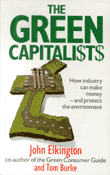

2001
The
Chrysalis Economy: How Citizen CEOS and Corporations Can Fuse Values and Value
Creation
John Elkington, Capstone Publishing/John Wiley, Oxford,
2001
The Chrysalis Economy focused on evolution: corporate, technological,
economic, political and, above all, cultural evolution. The book broke new
ground by looking at different business models, labelled: Corporate Locust,
Caterpillar, Butterfly, and Honeybee - or Beehive. A 5-stage model was presented,
dubbed the 'Learning Flywheel'. This ran from Invasion (where new activities,
business models or technologies created new impacts, or externalities), through
to the 5th stage of Incubation of totally new business models designed from
the outset with sustainability in mind.

1992
The Green Business Guide:
How to Take Up - and Profit from - the Environmental Challenge
John Elkington, Peter Knight and Julia Hailes, Victor
Gollancz, London, paperback.
This guide was designed to help business people come up the environmental
'learning curve'. The first chapter, interestingly, focused on the 'Green
Opportunity'. The book then turned to look at the roles of boards, laws, investor
relations, financial management, the 'environment portfolio', marketing, research
and development, project planning, manufacturing, the workplace, personnel,
and corporate communications. The final chapter explored the emerging sustainability
agenda for business, albeit with no mention yet of the triple bottom line.

1988
Green Pages: The Business of Saving the World
John Elkington, Tom Burke and Julia Hailes, Routledge,
London, paperback.
Green Pages sketched out the business agenda for the 1990s. Designed as the
first-stop source for green enterprise it featured contributions from the
likes of Jacqueline Aloisi de Larderel (as the then new director of UNEP's
Industry & Environment office), EC Commissioner Stanley Clinton Davis,
Petra Kelly (Die Grünen), Sir David Nickson (CBI), Anita Roddick (The
Body Shop International), Charles Secrett (Friends of the Earth) and Robert
Worcester (MORI). One 5-page section signalled where SustainAbility would
eventually head in the 1990s: a chapter on the coverage of environmental issues
in company annual reports.

1987
The Green Capitalists: How Industry Can Make Money
- and Protect the Environment
John Elkington with Tom Burke, Victor Gollancz, London, hardback 1987, paperback
1989.
The Green Capitalists blended the emerging green agenda with
that of business, causing political shock waves in the process. The central
message was that sustainable development would only be possible if we learned
how to work with business, through markets. Given that this was still two
years before the Berlin Wall fell, this primary focus on the roles of business
and markets was still highly unusual. It also broke new ground by introducing
'10 Steps to Environmental Excellence' in Chapter 10, 'environmental excellence'
being a term John had coined in 1984.

1997
Cannibals with Forks: The
Triple Bottom Line of 21st Century Business
John Elkington, Capstone Publishing, Oxford, hardback
1997, paperback 1999.
Short-listed for the Financial Times Best Business Book Award, Cannibals introduced
the concept of the 'triple bottom line' (TBL) - a term which John had coined
in 1994. The book asked whether capitalism itself was sustainable? It projected
the third pressure wave. And it looked at the ways in which TBL thinking would
transform accounting. The second major section identified and explored seven
drivers of the transformation: Markets, Values, Transparency, Life-Cycle Technology,
Partnerships, Time, and Corporate Governance.
1980
The Ecology of Tomorrow's World
John Elkington, Associated Business Press, London, hardback.
John's first proper book, drawing on work he had done primarily for New Scientist
(1975-1979) and The ENDS Report (from 1978). It sketched out the territory
we would cover over the next 20 years, with the environment depicted as an
'invisible asset', and other early chapters focusing on NGO campaigns, new
laws and rules and the development of environmental management techniques.
Other key sections covered: what would later be called eco-efficiency, project
appraisal, product design, and the evolution of 'environmental industries'.
The long-term horizon, covered in Chapter 10 was 1990, with even 1984 still
in the future.